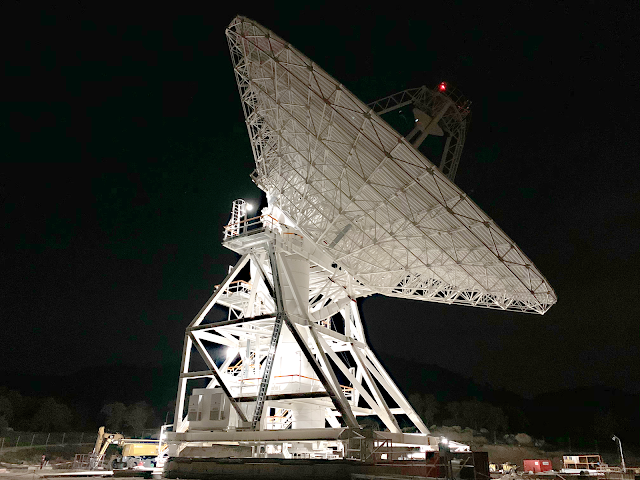NASA - Deep Space Network (DSN) logo.
March 16, 2022
Part of an ongoing project to grow the capacity of the Deep Space Network, which acts as a kind of interplanetary switchboard, the new antenna is the network’s 14th.
Image above: NASA’s DSS-53 antenna went online in February 2022 at the Deep Space Network’s Madrid facility. The addition is part of the agency’s effort to expand the capacity of the network, which supports about 40 missions and is expected to support another 40 that will launch in the coming years. Image Credits: NASA/JPL-Caltech.
There’s a powerful new member of NASA’s family of giant antennas that enable engineers and scientists on Earth to communicate with the growing number of spacecraft exploring our solar system.
Image above: With the addition of the DSS-53 antenna, the Madrid complex of NASA’s Deep Space Network is the first of the network’s three ground stations to have completed its build-out as part of project to expand network capacity. Image Credits: NASA/JPL-Caltech.
Called Deep Space Station 53, or DSS-53, the 111-foot (34-meter) antenna is part of NASA’s Deep Space Network (DSN). It’s now operational at the network’s facility outside Madrid, one of three such ground stations around the globe. The Madrid station is managed on NASA’s behalf by Spain’s Instituto Nacional de Técnica Aeroespacial (National Institute of Aerospace Technology). To mark the antenna’s debut, King Felipe VI of Spain attended the March 16 inauguration ceremony alongside NASA officials and dignitaries from Spain and the U.S.
Image above: NASA officials and dignitaries from Spain and the U.S. flank King Felipe VI of Spain at the inauguration of the DSN’s DSS-53 antenna. Kathy Lueders, associate administrator for the Space Operations Mission Directorate, and Badri Younes, deputy associate administrator for SCaN, led the NASA delegation. Image Credit: NASA.
“NASA is honored and humbled to have the king acknowledge this important milestone by joining us at the Madrid station. His inauguration of the Deep Space Station 53 antenna highlights the critical and historical collaboration between the Kingdom of Spain and the United States that, through the Deep Space Network, will continue to enable humankind’s exploration of the heavens for many years to come,” said Badri A. Younes, deputy associate administrator for Space Communications and Navigation (SCaN) at NASA Headquarters in Washington.
Managed by NASA’s Jet Propulsion Laboratory in Southern California for SCaN, the DSN allows missions to track, send commands to, and receive scientific data from faraway spacecraft. Now with 14 operational antennas, the network supports about 40 missions and is expected to support another 40 that will launch in the coming years.
Growing the Network
With so many missions to support currently and in the future, NASA began a project to expand the DSN more than a decade ago. DSS-53 is the fourth among six new beam waveguide antennas that the agency is adding to the network. When the project is complete, each ground station – Madrid, along with one in Canberra, Australia, and the Goldstone facility near Barstow, California – will have a total of four such antennas. The DSN’s three ground stations are spaced almost evenly around the globe so the network never loses sight of missions as Earth turns.
Built in Under 60 Seconds: The DSN Welcomes a New Antenna
Video above: Construction of NASA’s DSS-53 antenna at the Deep Space Network’s Madrid complex is shown from November 2018 to March 2020. A nearly two-year commissioning process followed – including installation of electronics and testing – before the antenna became operational in late February 2022. Video Credits: NASA/JPL-Caltech.
Together, the new antennas are capable of backing up each site’s 230-foot (70-meter) antenna. They also mean increased capacity to receive information on Earth – like images of the mysterious asteroid Psyche that the mission of the same name will acquire, or data from the forthcoming Europa Clipper mission revealing whether Jupiter’s icy moon has the capability to support life as we know it.
“This new antenna adds about 8% more capacity to the network. What it’s going to mean is 8% more science, and that’s really significant,” said JPL’s Bradford Arnold, the DSN project manager.
DSS-53 will act as a “workhorse” antenna capable of communicating on the frequencies most commonly used by NASA spacecraft. Its construction began in 2016. A complicated two-year commissioning period included a weekslong process when engineers and technicians adjusted each of the dish’s some 300 reflector panels, often as little as a quarter-turn of a screw, to optimize performance.
The new antenna follows DSS-56 coming online in Spain in early 2021, making the Madrid facility the first to have completed its build-out as part of NASA’s antenna-enhancement effort. The fifth new antenna in the effort, DSS-23, is expected to go online at Goldstone in 2025. The sixth antenna will be at the Canberra facility.
More About the Deep Space Network
The forerunner to the Deep Space Network was established in 1958 when JPL was contracted by the U.S. Army to deploy portable radio tracking stations in California, Nigeria, and Singapore to receive telemetry of the first successful U.S. satellite, Explorer 1. Shortly after JPL was transferred to NASA later that year, the newly formed U.S. civilian space program established the Deep Space Network to communicate with all deep space missions. It has been in continuous operation since 1963 and remains the backbone of deep space communications for NASA and international missions, supporting historic events such as the Apollo Moon landings and checking in on our interstellar explorers, Voyager 1 and 2.
Related links:
Deep Space Network (DSN): http://go.nasa.gov/about-dsn
Instituto Nacional de Técnica Aeroespacial (National Institute of Aerospace Technology): https://www.inta.es/INTA/en/
SCaN: https://www.nasa.gov/directorates/heo/scan/index.html
Canberra: https://www.cdscc.nasa.gov/
Goldstone: https://www.gdscc.nasa.gov/
Images (mentioned), Video (mentioned), Text, Credits: NASA/JPL/Ian J. O'Neill/Melissa Pamer.
Greetings, Orbiter.ch




